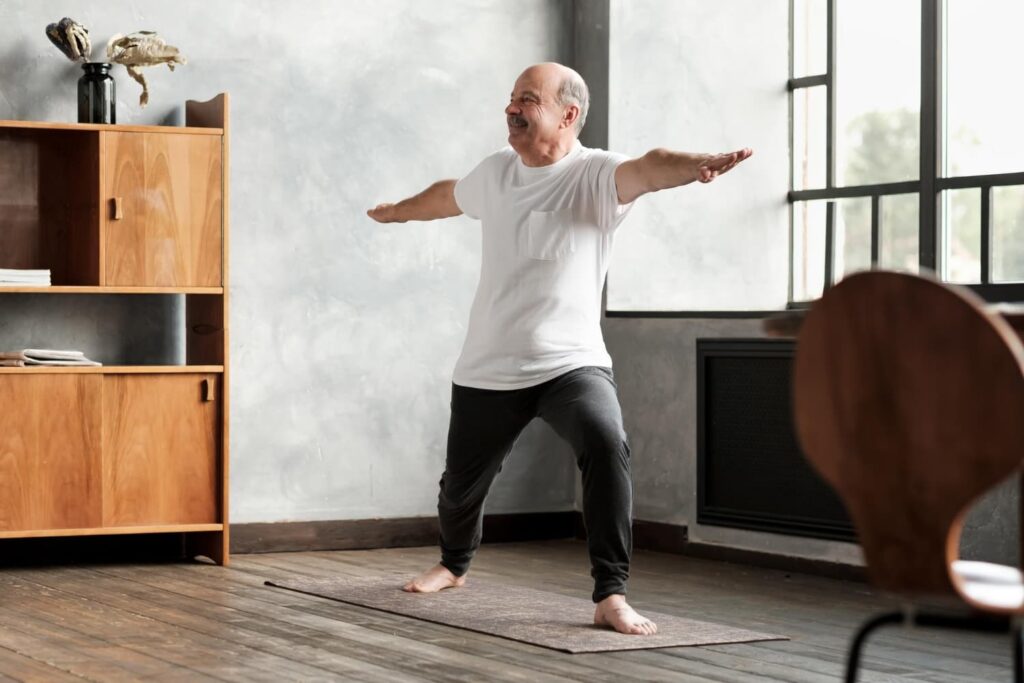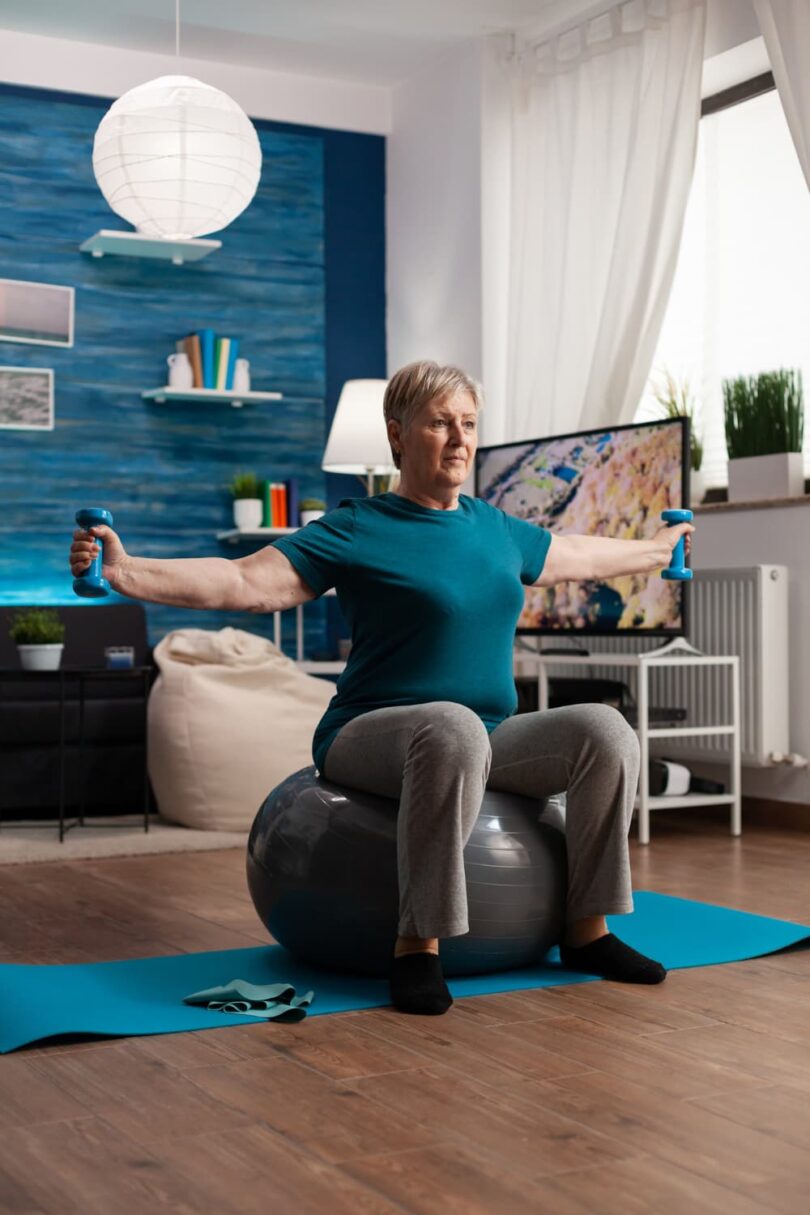Introduction
Staying active as we age is vital, yet it can be challenging to find exercises that are both safe and effective. Chair yoga offers a perfect solution, especially for seniors who want to maintain their flexibility, balance, and overall well-being without the intensity of traditional workouts. This article will guide you through a series of free chair yoga exercises for seniors that are not only simple but also beneficial. Whether you’re new to yoga or have some experience, these routines are tailored to fit your needs, making it easier to stay active and healthy.
Free Chair Yoga Exercises for Seniors: Simple and Effective Routine
Introduction to Chair Yoga for Seniors
As we grow older, our bodies often require gentler forms of exercise to stay fit and healthy. Chair yoga for seniors is a modified version of traditional yoga, designed specifically to be practiced while sitting or standing with the support of a chair. It’s an excellent option for older adults, particularly those with mobility challenges, as it allows them to maintain their flexibility and strength without putting too much strain on their bodies.
This form of yoga is incredibly accessible and doesn’t require any fancy equipment. All you need is a sturdy chair and a willingness to start. With consistent practice, you’ll find that these simple movements can make a significant difference in your daily life.
“Chair Yoga for Seniors: A Free Guide to Enhanced Wellbeing” using the rich anchor text chair yoga for seniors to provide readers with a more detailed guide on chair yoga practices.
Benefits of Chair Yoga
Improves Flexibility and Mobility
One of the biggest advantages of chair yoga exercises for seniors is how it helps improve flexibility and mobility. As we age, our muscles and joints tend to stiffen, making everyday movements more difficult. Chair yoga incorporates gentle stretches and movements that keep your body flexible and your joints well-lubricated. These exercises are especially beneficial for seniors who want to keep moving without overexertion.
For instance, a seated mountain pose might seem simple, but it’s incredibly effective in promoting good posture and stretching out the muscles in your back and shoulders. Over time, this can help in maintaining a greater range of motion, which is crucial for day-to-day activities.
Enhances Balance and Stability
Balance is another area where many seniors struggle, and it’s crucial for preventing falls. Chair yoga includes specific poses that are designed to improve balance and stability. Poses like the seated twist or the chair cat-cow help engage your core muscles, which are essential for maintaining balance.
Moreover, practicing these poses regularly can boost your confidence, making you feel more secure on your feet. With better balance, you’re less likely to suffer from falls, which is a common concern for many older adults.
Reduces Stress and Promotes Relaxation
Let’s face it—life can be stressful at any age, but it’s particularly important for seniors to find ways to manage stress effectively. Chair yoga is not just about physical exercise; it’s also a wonderful tool for mental relaxation. The focus on mindful breathing and gentle movements helps to calm the mind, reduce anxiety, and improve sleep quality.
Incorporating chair yoga into your daily routine can serve as a much-needed break from the hustle and bustle of life. It’s a time to connect with your breath, let go of stress, and promote relaxation, leading to a more peaceful and restful state of mind.
Getting Started with Chair Yoga
When starting any new exercise routine, it’s important to set yourself up for success. Chair yoga is no exception. With just a few simple preparations, you’ll be ready to dive into this practice, whether you’re aiming to increase flexibility, balance, or simply find a bit of peace in your day.
Selecting a Suitable Chair
The first step in getting started with chair yoga is choosing the right chair. The ideal chair should be sturdy, stable, and without wheels—no need for it to slide around while you’re focusing on your movements! A chair with a straight back and no arms is preferable, as it allows for greater freedom of movement. If possible, choose a chair that lets your feet rest flat on the ground to provide a solid base of support.
If you find that your chair is a bit too tall, place a firm cushion under your feet. This adjustment helps maintain proper posture during your practice, which is key to performing the poses correctly and safely.
Warm-up Exercises for Seniors
Before jumping into the main chair yoga poses, it’s important to warm up your body. These gentle warm-up exercises are designed to prepare your muscles and joints for the stretches and movements to come. Plus, warming up helps to prevent injuries and makes the entire practice more comfortable.
Here are a few simple warm-up exercises to get you started:
- Neck Rotations: Slowly turn your head to the right, then to the left, and finally in a full circle. Repeat a few times in each direction. This helps loosen up the muscles in your neck and shoulders.
- Shoulder Rolls: Roll your shoulders forward in a circular motion, then reverse the direction. This movement helps release tension in the upper back and shoulders.
- Ankle Circles: Lift one foot off the ground and rotate your ankle in slow, controlled circles. Switch directions, then repeat with the other foot. Ankle circles are great for warming up the joints and improving circulation.
Taking a few minutes to warm up can make a world of difference, helping you ease into the more structured chair yoga poses that follow.
Basic Chair Yoga Poses
Now that you’re warmed up, it’s time to move into some basic chair yoga exercises. These poses are designed to be simple yet effective, making them accessible to seniors at any fitness level. The beauty of chair yoga lies in its adaptability—you can make each pose as easy or as challenging as you need, depending on your comfort level.
Here are a few fundamental poses to start with:
- Seated Mountain Pose: Sit up straight with your feet flat on the floor, hands resting on your thighs, and shoulders relaxed. Engage your core and imagine a string pulling the top of your head toward the ceiling. This pose promotes good posture and helps you connect with your breath.
- Chair Cat-Cow: Place your hands on your knees. On an inhale, arch your back and lift your chest, allowing your belly to drop (Cow Pose). On the exhale, round your back, tuck your chin to your chest, and pull your belly button toward your spine (Cat Pose). This sequence stretches the spine and improves flexibility in the back.
- Seated Forward Bend: With your feet hip-width apart, slowly hinge forward from your hips, reaching your hands toward the floor or your ankles. Keep your back straight as you fold forward. This pose stretches the hamstrings and lower back, helping to relieve tension.
These poses form the foundation of your chair yoga practice. As you become more comfortable with these movements, you can start to explore more advanced variations and routines. But remember, the key is consistency—regular practice is what brings the greatest benefits.
In the section on Basic Chair Yoga Poses, link to “Chair Yoga Program for Seniors: Enhancing Wellness One Pose at a Time” with the anchor text enhancing wellness one pose at a time.

Safety Precautions for Chair Yoga
Before diving into any exercise routine, particularly for seniors, it’s crucial to prioritize safety. Chair yoga is generally safe, but taking a few precautions can help you avoid unnecessary strain or injury.
First and foremost, it’s wise to consult with your healthcare provider before beginning chair yoga, especially if you have any existing health conditions like arthritis or chronic pain. Your doctor can provide personalized advice on how to adjust the exercises to fit your needs.
While practicing, listen to your body. If a pose feels uncomfortable or causes pain, it’s okay to stop or modify it. Remember, the goal is to feel better, not to push yourself too hard. Start slow, and as your confidence grows, you can gradually increase the intensity of your sessions. Also, keep a water bottle handy and stay hydrated—this is key to keeping your muscles and joints healthy.
Mental Health Benefits of Chair Yoga
Chair yoga isn’t just about physical health; it’s also a powerful tool for improving mental well-being. Regular practice can have a profound impact on your mood, cognitive function, and overall sense of calm.
For starters, chair yoga incorporates breathing exercises that help reduce stress. By focusing on your breath, you can shift your attention away from worries and into the present moment. This kind of mindful breathing is known to lower levels of the stress hormone cortisol, which in turn can help alleviate anxiety and improve sleep.
In addition, the gentle movement in chair yoga helps release endorphins—your body’s natural mood lifters. These “feel-good” chemicals can combat feelings of depression, boost your energy levels, and leave you with a greater sense of well-being. For seniors who may feel isolated or lonely, chair yoga can also provide a sense of connection, whether practiced in a group or even just through following along with an online video.
Moreover, studies suggest that regular yoga practice can improve cognitive functions such as memory and concentration. By combining physical movement with mindful focus, chair yoga encourages a mind-body connection that sharpens your mental acuity.
“The Mental Benefits of Yoga: Nurturing Mind and Spirit” using the anchor text nurturing mind and spirit to provide readers with deeper insights into how yoga can benefit mental health.
Staying Consistent with Your Practice
One of the most important aspects of any exercise routine is consistency. The benefits of chair yoga, like improved flexibility, balance, and mental clarity, are best achieved through regular practice. But let’s be honest—sticking to a routine can be tough, especially when life gets busy or motivation wanes.
To help maintain consistency, try setting a regular time for your chair yoga sessions. Whether it’s first thing in the morning or right before bed, establishing a routine makes it easier to stay on track. Additionally, practicing with a friend or joining a class can make the experience more enjoyable and keep you motivated. Even if you’re practicing alone, setting small, achievable goals—like adding a new pose each week—can keep things interesting.
It’s also helpful to remind yourself why you’re doing this. Reflect on how you feel after each session—whether it’s more relaxed, energized, or simply at peace. These positive feelings can serve as motivation to keep coming back to your chair yoga practice day after day.
Free Resources and Online Support
If you’re looking to dive deeper into chair yoga or simply want to add variety to your practice, there are numerous free resources available online. These resources range from video tutorials to full-length classes, making it easy to practice chair yoga in the comfort of your own home.
Websites like YouTube are filled with free chair yoga videos tailored specifically for seniors. These videos often feature step-by-step instructions, making them perfect for beginners. Additionally, several online communities and forums are dedicated to senior wellness, offering a platform to connect with others who share your interest in chair yoga. These communities can be a great source of motivation and support.
Frequently Asked Questions (FAQs)
Can anyone do chair yoga?
Yes, chair yoga is designed to be accessible for all fitness levels, including those who may have mobility challenges. It’s a gentle form of exercise that can be adapted to suit individual needs. However, it’s always a good idea to consult with a healthcare professional before starting any new exercise routine.
Is chair yoga safe for seniors with joint issues?
Absolutely. Chair yoga is particularly beneficial for seniors with joint issues because it involves gentle, low-impact movements. These exercises help to maintain joint flexibility and can be modified to accommodate any limitations.
How often should seniors practice chair yoga?
Seniors can start with 2-3 sessions per week and gradually increase the frequency as they become more comfortable with the movements. Consistency is key to experiencing the benefits, but it’s also important to listen to your body and rest when needed.
Can chair yoga help with arthritis?
Yes, chair yoga’s gentle movements can be very helpful for those suffering from arthritis. The stretches and poses help to reduce stiffness and improve joint function, but it’s essential to modify the exercises based on your comfort level and consult with a healthcare professional for personalized advice.
Are there specific chair yoga poses for back pain?
Indeed, there are several chair yoga poses designed to relieve back pain. Poses like the seated forward bend and gentle twists target the muscles in your back, providing relief from tension and discomfort.
Conclusion
In conclusion, free chair yoga exercises for seniors offer a wonderful way to stay active, improve flexibility, and support mental well-being, all from the comfort of a chair. Whether you’re looking to maintain your balance, reduce stress, or simply add some gentle movement to your day, chair yoga is an accessible and effective option. Remember to stay consistent with your practice, seek out resources that resonate with you, and most importantly, listen to your body.
So, why wait? Grab a chair and start your journey towards better health and wellness today!








